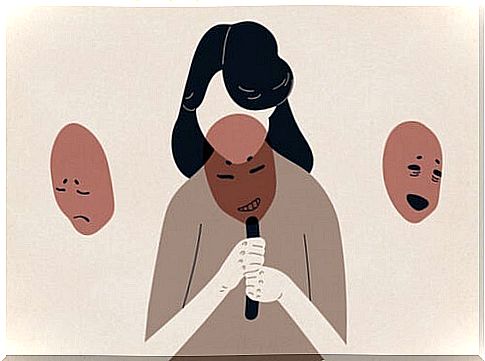Seven Techniques Derived From Psychodrama

Psychodrama is a therapeutically derived technique, or a set of techniques that focus on staging and dramatizing reality from a particular perspective. Techniques derived from psychodrama seek to encourage the expression of unexpressed, repressed, or poorly understood emotions in order to promote cathartic and behavioral change. There are different techniques.
The elements to be worked on can be memories, as well as current and future events. Thus, the technique is useful for all types of disorders ranging from depression to the anxiogenic spectrum, eating disorders, and emotional management problems.

What is the purpose of techniques derived from psychodrama?
Psychodrama has several goals, e.g.
- To get a more real and deeper understanding of a particular situation. You can apply it to situations you have experienced a long time ago. For those whose wounds have not healed, and also for distressing situations that will cause stress in the future. Techniques derived from psychodrama can help you connect with your feelings. It means contacting them and ideas and thoughts that may not usually have a place in your daily life.
- Understand perspectives that are different from yours. Many techniques derived from psychodrama allow you to see another person’s position in relation to conflict. Considering other perspectives and participating in discussions can help you develop empathy and understand the motivation for certain actions.
- Hone your skills. Some psychodrama-derived techniques allow you to take on roles that you may not be able to handle. They can serve as an education to experience other attitudes, behaviors, and even personality aspects.
Psychodramatic rules
The goal of techniques derived from psychodrama is that the subject or protagonist, as is commonly referred to in the art, does not describe his contradictions orally. It differs from the usual way people share, manage, and think about their problems. The goal is to be genuine and profound.
Psychodrama usually requires a group of performers as well as an audience. However, any performance can take place with a smaller number of people or even alone. In this case, it is a monologue.
For example, in a presentation with more people, partner representation can help understand other people’s behavior. Thus, the protagonist acts according to his feelings and criteria within the framework of his subjective reality.
Psychodrama is suitable for a wide variety of people, including the shy or withdrawn. Leading technology can even be reserved or unnatural, but it works as long as no one forces the main character into anything.
A change in psychodrama
What is really interesting about techniques derived from psychodrama is that dramatization can be used to achieve vision, awareness, and understanding.
The presence or words of the therapist are not necessary. Thus, insight is accessed spontaneously from the presentation, and no external advice is needed at all.
Techniques derived from psychodrama
Clarification of internal dialogue
The Sololoquy technique is that the main character expresses his thoughts and feelings before encountering a particular situation. This situation can distress them in the present by making the future uncertain, or because it has distressed them in the past. This can be useful, for example, when you receive a call from your supervisor or when during a dispute you are afraid your partner will leave you.
Likewise, side technique is useful for getting in touch with what you are thinking and feeling before a particular event that does not usually occur. The main character tries to express out loud what he has remained silent due to fear or confusion, using this technique during dialogue, confrontation, or conversation. It’s like parentheses that allow a person to connect with their reality.
Switching roles
This technique consists of presenting the concrete situation in which you are immersed. It can be even a conversation with a friend or a business meeting.
The intent is for the main character to play another role, the role of the person with whom he or she has argued or has behaved badly towards him or her. The protagonist must understand the situation from another perspective and thus be able to create other kinds of emotions to understand what made the other act the way he did.
The main character and assistant
Some of these techniques require the presence of an extra ego. This ego wants to make room for those forgotten aspects of interaction. They often contain valuable information.
Apuego stands behind the protagonist of the doubling technique and speaks as an extension of the discussion on things that the protagonist has not expressed. He does so when the latter speaks.
Unclear things are usually threatening, whether painful or semi-conscious. The ego returns the alienated parts of itself to the protagonist. It takes them to more secret levels by expressing things it considers important.

There is also an extra ego in mirroring technique, but he does not speak. He stands primarily in front of the protagonist and mimics his wordless behavior as he dramatizes the situation. It includes gestures, postures, stitches and expressions.
Elements that are generally considered important are words that a person expresses. Nonverbal behavior also matters, and can ultimately be much more informative than the message itself.
Changing reality
Techniques based on psychodrama, such as extraordinary reality, allow the protagonist to have a second experience of what happened. This reality is trying to undo the events as they happened. This allows the protagonist to experience them differently.
Experiencing past situations so that they would have happened the way you want can help you understand the pain of certain situations. In addition, it can help to have another symbolic reality that can deepen the pain and allow it to heal.
A situation where a person is afraid to live on their own is placed in a substitute role in technology. This is similar to changing roles. It can be, among other things, a childhood memory, a session with project managers, or the loss of a partner.
Conclusion
The purpose of these exercises is to allow the protagonist to look at a particular situation without the emotional charge that is brought about by an outside role.
It’s about living a childhood memory as another person: even a brother, cousin, or neighbor. The goal is to dramatize the loss of a partner as a viewer, a friend who sees everything. It can help us emotionally detach ourselves from a situation and see the situation differently and more quietly so that we can think, understand and integrate.
Dramatization is thus a good resource for achieving catharsis and behavior change by understanding our own feelings. Not only is it helpful in healing psychological disorders, but it is also very helpful for those who want to rediscover themselves, unwind emotionally, and connect with the feelings and thoughts they have kept in the shadows.









